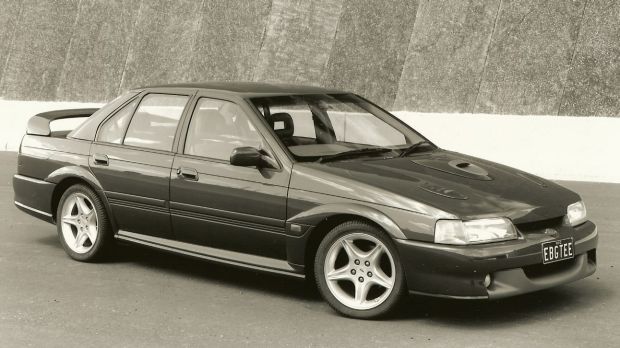
As we continue to trace the history of the Australian Ford Falcon ahead of the closure of the Broadmeadows and Geelong manufacturing facilities in October, we look back at the tumultuous 1990s - a roller coaster decade for the Blue Oval's bread-and-butter line-up.

Falcon EB
Years of production: 1991 to 1993
Number produced: 121,221
Biggest achievement: Return of the V8.
You need to have a pretty keen eye to spot the differences between the EB and the car it replaced, the EA. But under the skin there was more to it. The EB gave us our first taste of (optional) ABS brakes in a local Falcon and other safety areas were also addressed including foam-filling the A-pillars and offering a three-point centre-rear seat-belt. The EB kicked off with the 3.9-litre EFi engine but, for Series 2 cars, that grew to a full four litres; a capacity the Ford six retained till the very end. But the EB was also the model that reintroduced the V8 engine, in this case a five-litre injected unit. Ford also based the 25th anniversary Falcon GT on the EB, though it was hardly the landmark car it should have been. More significant was the establishment of the Tickford performance division and the introduction of the long-lived XR6 and XR8 badges.

Falcon ED
Years of production: 1993 to 1994
Number produced: 72,571
Biggest achievement: Refining the XR concept.
If the EB was hard to discern as a new model, the ED was too, unless you were looking at it from the front. At which point you'd have noticed a curiously oval-shaped grille opening that gave the ED a slightly Murray Cod visage. The ED's main claim to fame is that it was the model that really started to refine and define what it was to be an XR6 or XR8. Both models had proven popular in the EB version, so Ford spent its development budget on making those models look and feel different. It worked, too, and the quad headlight treatment pioneered by the ED became a long-standing XR design cue

Falcon EF
Years of production: 1994 to 1996
Number produced: 192,100
Biggest achievement: More refinement.
The doors and roofline might have remained from the previous models, but the EF represented a major restyling. More rounded, swoopier front and rear styling was grafted on to the bodyshell pioneered with the EA, and the result was a much more modern looking vehicle. A driver's airbag became standard in every EF Falcon. The four-litre six-cylinder came in for major revision to smooth it out, too, with hydraulic engine mounts, a counterweighted crankshaft and a dual-resonance intake manifold. In fact, with the changes in place, the new six gave the five-litre V8 a real hurry-up in the power department. So much so, in fact, that for the first time Ford gave the XR8 model a power-up over the standard V8 version with a total of 170kW.

Falcon EL
Years of production: 1996 to 1998
Number produced: 140,795
Biggest achievement: Calm before the storm.
The last of a series is often the best and so it was with the EL Falcon, the last of the E-Series pioneered by the EA. It didn't look much different, but Tickford's engineers had discovered that if they lowered the pivot point of the Watts-linkage at the rear, the front and rear of the car were suddenly talking to each other. The result was a much more benign handler. Engine wise, the EF's troublesome coil-pack ignition reverted to a distributor-style for the EL. The GT also made a return in the EL, this time with a five-litre engine claiming 200kW. It was a pretty complete package, too, with tweaks to the engine, clutch, handling and gearing. And of course, that wild body-kit.

Falcon AU
Years of production: 1998 to 2002
Number produced: 322,838
Biggest achievement: Handed the trophy to Holden.
The AU will not be remembered as one of Ford Australia's finest moments. There were several reasons for this, including the fact that it coincided with Holden's mega-successful VT model. And when you consider that the VT was a great looking car, the AU's ugly-duckling status was even more critical. But ugly was more than skin deep with the AU and the dashboard was an inexplicable collection of curves and organic shapes that was hastily redesigned for the Series 2 model. In fact, Ford moved quickly to blunt the polarising aspect of the car and there were actually three versions of the AU, none of which were a match for the Holden. In fact, the AU gave Holden the free kick it needed to take a lead over Ford in the sales race; a lead it would never give up. Especially once Ford had alienated its fleet customers by ditching the fleet-discount scheme.

Comments